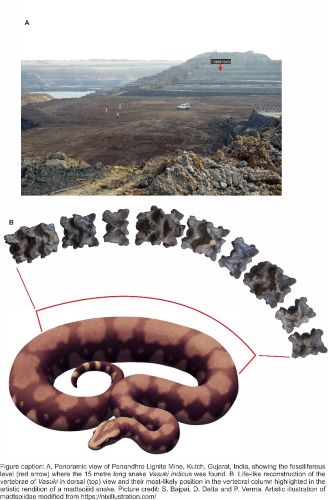IIT Roorkee researchers discover ancient giant snake fossil in Gujarat

IIT Roorkee Researchers Discover Ancient Giant Snake Fossil in Gujarat
Team L&M
In a remarkable discovery by Prof Sunil Bajpai and post-doctoral fellow Debajit Datta from the Indian Institute of Technology (IIT), Roorkee, an ancient species of snake believed to be one of the largest ever to have roamed the Earth has been unveiled. This ground-breaking find adds to the institution’s growing list of significant fossil discoveries, further solidifying IIT Roorkee’s reputation as a leader in paleontological research.
The newly identified snake, named Vasuki Indicus, inhabited the region of present-day Gujarat around 47 million years ago during the Middle Eocene period. It belonged to the now-extinct Madtsoiidae snake family but represented a unique lineage from India.
The discovery of Vasuki Indicus is truly astounding! Imagine a snake that could have stretched out to be as long as a school bus, measuring between 11 to 15 metres! This ancient giant’s fossils were found in the Panandhro Lignite Mine in Kutch, Gujarat. Among these fossils, 27 vertebrae were exceptionally well-preserved, with some even found connected or articulated, like jigsaw puzzle pieces.
When scientists looked at these vertebrae, they noticed something interesting about their shape and size. They suggest that Vasuki Indicus had a broad and cylindrical body, hinting at a robust and powerful build. Vasuki Indicus isn’t just any snake we’re talking about; its size rivals that of Titanoboa, a massive snake that once roamed the Earth and holds the title of the longest snake ever known.
Now, how did Vasuki Indicus live? Researchers believe it was a stealthy hunter. Like anacondas we see today, Vasuki Indicus likely moved slowly and waited for the right moment to ambush its prey. Its large size would have made it a formidable predator in its ancient ecosystem.
Vasuki Indicus is unique and named after Vasuki, the mythical snake often depicted around the neck of the Hindu god Shiva. This name not only reflects its Indian roots but also gives a nod to the region’s rich cultural heritage. The discovery of Vasuki Indicus sheds new light on the biodiversity and evolution of snakes during the Eocene period. It also offers insights into the geographical spread of the madtsoiidae family, which existed for approximately 100 million years across Africa, Europe, and India.
Prof Sunil Bajpai, Department of Earth Sciences, IIT Roorkee, remarked, “This discovery is significant not only for understanding the ancient ecosystems of India but also for unravelling the evolutionary history of snakes on the Indian subcontinent. It underscores the importance of preserving our natural history and highlights the role of research in unveiling the mysteries of our past”
Appreciating the discovery, Prof. K.K. Pant, Director of IIT Roorkee, said, “We are immensely proud of this remarkable discovery by Prof Sunil Bajpai and his team. The unveiling of Vasuki Indicus underscores IIT Roorkee’s commitment to advancing scientific knowledge and our relentless pursuit of excellence in research. Such discoveries enrich our understanding of our planet’s history and elevate IIT Roorkee’s stature on the global scientific stage.”
This discovery by Prof Sunil Bajpai and his team follows a recent wave of significant fossil findings in India. IIT Roorkee’s continued contributions to paleontological research have reinforced India’s prominence as a hotspot for substantial discoveries. The uncovering of Vasuki Indicus further adds to the growing list of ground-breaking fossil discoveries from IIT Roorkee, reinforcing India’s importance in this important discipline.



1 Comment
We finally have a proof of the Samudra Manthan and existence of Vasuki Naag. Thanks to the scientists and researchers!